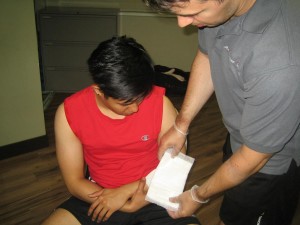Overview
Bleeding, no matter how severe this may be, must always be controlled. If a person who is bleeding is not helped, then this could lead to shock or death due to blood loss. It may be up to you to stop the bleeding while waiting for an ambulance to arrive. You should never get the bleeding to stop as soon as possible. Getting the bleeding to stop is only half of the solution. The following information is going to help you to learn how to control bleeding in someone so that you can potentially save their lives.
Apply Direct Pressure

This is the first step in stopping blood flow. The blood needs to clot in order to stop, thus you need to control this through plugging the hole or applying direct pressure to stop the flow of the blood. You will want to apply direct pressure to the wound. If you have something to use as gauze, then do this. This is going to help to hold the blood in place and may help to promote clotting. Once you put the gauze onto the wound, never remove it. If blood is seeping through, keep adding layers so that the wound will clot.
Elevate the Wound above the Heart
You will want to elevate the wound if this is possible, above the heart. Blood flow slows down when the body part is above the heart. When the blood flow has slowed down, you will find it easier to stop blood flow with direct pressure.
Utilize Pressure Points
If you know what you are doing, you can press on the pressure points throughout the body that can help to slow the flow of blood. You always want to press a point that is closer to the heart, rather than being close to the wound. Here are some of the more common pressure points for stopping blood flow:
- The brachial artery located between the shoulder and elbow
- Femoral artery located in the groin
- Popliteal artery located behind the knee
When is a Tourniquet Needed?
Tourniquets are not necessary with every wound a person may have. Thus, these are hardly ever applied. They do restrict blood flow to the point that it could cause further damage. With this being said, this is an option when times are desperate, and it may mean making a decision between bleeding to death or losing the limb.
Related Video On Bleeding
